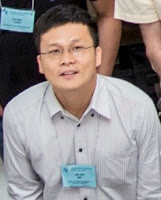2018 GRC NPC
Jun Ma (Sun Yat-Sen Medical University, China)
“Comprehensive Treatment Strategy in Locoregionally Advanced Nasopharyngeal Carcinoma”
- Evolving National Comprehensive Cancer Network’s (NCCN) guidelines (2018) of the nasopharynx
Induction chemotherapy plus concurrent chemoradiotherapy versus concurrent chemoradiotherapy alone in locoregionally advanced nasopharyngeal carcinoma: a phase 3, multicentre, randomised controlled trial.
Sun Y1, Li WF1, Chen NY2, Zhang N3, Hu GQ4, Xie FY1, Sun Y5, Chen XZ6, Li JG7, Zhu XD8, Hu CS9, Xu XY10, Chen YY6, Hu WH1, Guo L11, Mo HY11, Chen L1, Mao YP1, Sun R1, Ai P2, Liang SB3, Long GX4, Zheng BM5, Feng XL6, Gong XC7, Li L8, Shen CY9, Xu JY10, Guo Y12, Chen YM13, Zhang F1, Lin L1, Tang LL1, Liu MZ1, Ma J14.
Abstract
BACKGROUND:
The value of adding cisplatin, fluorouracil, and docetaxel (TPF) induction chemotherapy to concurrent chemoradiotherapy in locoregionally advanced nasopharyngeal carcinoma is unclear. We aimed to compare TPF induction chemotherapy plus concurrent chemoradiotherapy with concurrent chemoradiotherapy alone in a suitably powered trial.
METHODS:
We did an open-label, phase 3, multicentre, randomised controlled trial at ten institutions in China. Patients with previously untreated, stage III-IVB (except T3-4N0) nasopharyngeal carcinoma, aged 18-59 years without severe comorbidities were enrolled. Eligible patients were randomly assigned (1:1) to receive induction chemotherapy plus concurrent chemoradiotherapy or concurrent chemoradiotherapy alone (three cycles of 100 mg/m2 cisplatin every 3 weeks, concurrently with intensity-modulated radiotherapy).
Development and validation of a gene expression-based signature to predict distant metastasis in locoregionally advanced nasopharyngeal carcinoma: a retrospective, multicentre, cohort study.
Tang XR1, Li YQ1, Liang SB2, Jiang W3, Liu F4, Ge WX5, Tang LL1, Mao YP1, He QM1, Yang XJ1, Zhang Y1, Wen X1, Zhang J1, Wang YQ1, Zhang PP1, Sun Y1, Yun JP1, Zeng J1, Li L1, Liu LZ1, Liu N1, Ma J6.
BACKGROUND:
Gene expression patterns can be used as prognostic biomarkers in various types of cancers. We aimed to identify a gene expression pattern for individual distant metastatic risk assessment in patients with locoregionally advanced nasopharyngeal carcinoma.
METHODS:
In this multicentre, retrospective, cohort analysis, we included 937 patients with locoregionally advanced nasopharyngeal carcinoma from three Chinese hospitals: the Sun Yat-sen University Cancer Center (Guangzhou, China), the Affiliated Hospital of Guilin Medical University (Guilin, China), and the First People’s Hospital of Foshan (Foshan, China). Using microarray analysis, we profiled mRNA gene expression between 24 paired locoregionally advanced nasopharyngeal carcinoma tumours from patients at Sun Yat-sen University Cancer Center with or without distant metastasis after radical treatment. Differentially expressed genes were examined using digital expression profiling in a training cohort (Guangzhou training cohort; n=410) to build a gene classifier using a penalised regression model. We validated the prognostic accuracy of this gene classifier in an internal validation cohort (Guangzhou internal validation cohort, n=204) and two external independent cohorts (Guilin cohort, n=165; Foshan cohort, n=158). The primary endpoint was distant metastasis-free survival. Secondary endpoints were disease-free survival and overall survival.
 |
| 對啊,那是我發的!!! |
2016 GRC NPC
Jun Ma 馬駿 (Sun Yat-Sen Medical University, China)
“NPC Clinical Trials in Guangzhou”
Roger Ngan (Queen Elizabeth Hospital, Hong Kong SAR China)
“Evolution of NPC Clinical Trials in Hong Kong”
中山大學附屬腫瘤醫院馬駿團隊的研究成果寫入美國教科書成美歐指南 (http://goo.gl/mPcswZ)
- 3500 NPC patient /yr (In their institute)
- 12台 Linear particle accelerator (LINAC) treating 800 patients /day
- Landmar 0099 trial in 1988 (J Clin Oncol 1998 and Lancet Oncol 2012)
- NCT submitted
- NCT01872968 recruiting
- NCT3211476 13 centers
- Radiotherapy is for early stage patients (T1–>2N1 RT or RT+CCRT)
- advanced : T3+T4
- IMRT + CCRT did not improve survival !! (因為IMRT是依image打雷射,通常處理地很好, 加了CCRt反倒讓病人增加許多chemotherapy之副作用)
Jin-Xin Bei (Sun Yat-Sen University Cancer Center, China)
“Genetic Basis of Nasopharyngeal Carcinoma” 貝錦新
- Bai-Yue origin (Wee et al., 2010)
- HLA linkage (HLA-A2 Simons et al 1974, HLA locus Lu et al 1990)
- Ch 4.2, Ch 4.177, Ch2.1 (Feng et al, 2002, Xiong et al, 2004, Hu et al 2008, Hildeshiam et al 2012, Bai et al, 2012)
- Candidate gene approach )awaits for validation)
- NPC GWAS (ch3 MECOM and ITAG9, ch13 TRFRSF1, ch6 HLA-A x 2)
- However, these GWAS studies only exprealined 2.2% genetic variance (HLA II and CIITA (controls EBV lytic replication, Manolio et al Nature 2009)
- Extended GWAS studies (Cui et al., Hum Mol Gene accepted)
- Exome-wide association study (KLHDC4) Lian et al PLoS One 2016
- The best predictive model so far: EBV variants (including CIITA and 7 host SNPs Cui et al, Oncotarget, accepted )
- EBV subtypes (Feng et al., Chin J Cancer)
- NKT cell lymphoma DPB1-aa 84 (Lancet Oncol)
 |
| 瑪麗亞,別忘了廣西呀 |
————————–
From Ming-Han
- @Whether NPC high incidence population all migrated from “Bai-Yun” village of China? (Wee et al 2010)
- -EBV subtype to NPC? General population+environmental factor cause NPC? Genetic (HLA-A2) cause NPC?
Three highly mutated regions specific to NPC:
- TNFRSF19
- MECOM
- ITAG9
Cui et al: human Mol Genetics (accepts): study >1000NPC and control genetics.